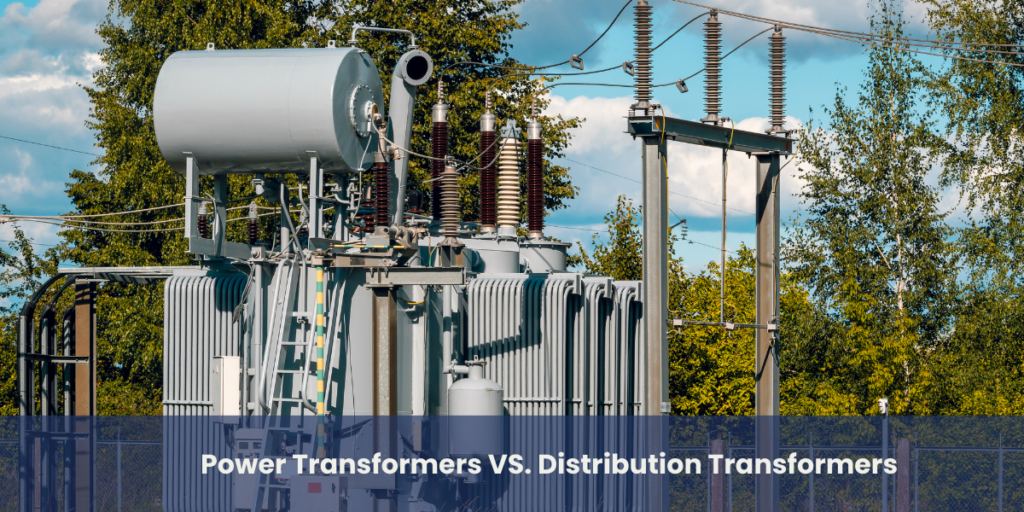

Difference Between Power Transformer and Distribution Transformer

Two anchors are at the center of the electrical engineering landscape: power transformer and distribution transformer. These transformers are a core component of the electrical grid, which makes sure that energy flows seamlessly. We’ll examine the basics, applications, and key differences between power transformers vs distribution transformers, these will be a comprehensive exploration covering vital components that underpin our contemporary world.
What is a Power Transformer?
In principle, the Power Transformer is a robust electrical device used to carefully control voltage levels when transmitting electricity over long distances. The main activity of a Power Transformer, whether stepping up or stepping down voltage, is to permit efficient and lossless power transfer across the complex network of the electrical grid.
Applications of Power Transformers:
Long-Distance Power Transmission:
Behind this grand task of delivering electricity over miles, Power Transformers are the unacknowledged heroes. They minimize energy losses through the use of high voltage transmission lines so that electricity flows as efficiently on the grid as possible.
Substation Interconnections:
Power Transformers serve as the focal point for connecting different sections of the electricity grid in strategic locations at substations. Interconnectedness optimises the efficiency of a complete electricity network, ensuring that it flows continuously and reliably.
Grid Integration of Renewable Energy:
With an increasing emphasis on renewable energy sources such as wind and solar, power transformers have a key role in seamlessly integrating these transient energy inputs into the existing power grid. They act as intermediaries to ensure a harmonious integration of renewable energy into the more sustainable power landscape.
What is a Distribution Transformer?
On the flip side, we are equipped with the Distribution Transformer, which is a smaller but just as crucial electrical device. The distribution transformers, unlike their heavier counterparts, take a primary step down in the voltage level which allows electricity to be distributed locally by end users. Distribution transformers are located in residential, business, and industrial zones that bring electricity nearer to where it is required.
Applications of Distribution Transformers:
Urban and Rural Power Distribution:
Distribution Transformers supply power to bustling cities and quiet countryside, thereby becoming a neighborhood champion. They are designed to accommodate the diverse needs of consumers in different environments by adjusting their voltage levels.
Industrial Applications:
Power distribution transformers are of utmost necessity for industry to obtain electricity at proper voltage levels. These transformers have a key role to play in promoting the different manufacturing processes that contribute to the industry’s productivity.
Residential Power Supply:
The distribution transformers are the overlooked managers of our daily lives that supply electricity to households at stable and usable voltage levels. The distribution transformers operate discreetly to deliver the energy that you need each time you turn on a switch or power your devices.
Power Transformer Vs Distribution Transformer
A careful examination of the subtle differences that define their roles in electrical engineering’s grand tapestry is essential to get a picture of what these transformers are.
Voltage Levels:
Power Transformer: For the purpose of long distance transmission, specific attention is paid to handling high voltage levels. It acts as the gatekeeper for electricity embarking on an extensive journey.
Distribution transformers: adjust the voltage to ensure that end users are supplied with electricity at a suitable level for consumption. For our everyday needs, it’s a local hero that generates power.
Size and Design:
Power transformers: They have a more robust design, specifically adapted for the heavy duty applications of high-power and long-distance transmission. Consider it as the heavyweight champion in the transformer arena.
Distribution transformers: They have a more compact and streamlined design, so they’re ideal for localized distribution. This is an agile and dynamic transformer that has a seamless integration into neighborhood settings.
Location of Installation:
Power Transformer: is strategically located in key junctures of the electricity network at power stations and major Substations. It is a central command to transmit electricity over the distance.
Distribution transformers: are installed in close proximity to end users, who live in urban and industrial areas. This transformer is the friendly neighbor who ensures that electricity is easily available when it needs to be.
Functionality:
Power transformers: primarily focus on the efficient transmission of power over a wide range of distances. It’s like a backbone for the electric grid, supporting its great symphony.
Distribution Transformer: The primary aim is to deliver electricity at the right level of voltage for end users. It is a local maestro, tuning the electric harmony for everyday consumption.
Through this blog, we did not just look into the basic functioning and underlying differences, comparing Power Transformer Vs Distribution Transformer, but we extend to the extensive interconnectedness of both electrical entities as they sustain our modern electrical infrastructure. In the following section, we will delve into their harmonious working, challenges to their functioning, and resolution of it through innovation.
The Symbiosis in Action:
Let’s take a scenario where electricity is produced at the power plant. For the effective long distance transmission of electricity through High Voltage Transmission Lines, Power Transformers increase their voltage. Distribution transformers step in to lower the voltage when electricity arrives at its destination, making it suitable for local distribution. This tag team approach ensures an optimal and safe transmission of energy to every part of our daily lives.
Future Horizons: Challenges and Innovations:
As we depend on and contribute to technological advancements and the ever-changing energy landscape, the nature of power transformer and distribution transformer become subjected to challenges and the need for innovation in their utility.
Emerging Challenges:
The increasing demand for electricity and the consequent need to build up more transmission capacity are some of the challenges faced by Power Transformers. To improve the efficiency and capacity of these transformers, innovations in materials, design, and monitoring systems are being explored.
Bringing Innovations:
Innovation in the area of distribution transformers is driven by increasing energy efficiency, minimising losses, and integrating smart technologies. In the quest for a more reliable and efficient electrical grid, smart distribution transformers that are fitted with sensors and communications systems will become increasingly important.
Conclusion:
To conclude, power transformer and distribution transformer are pillars of our Electrically Integrated civilization as they play a fundamental role in ensuring the effective transmission and distribution of energy. Through power plants, substations, neighborhoods, and industries that power our modern lives, the symphony they create is resonant. It’s not just an academic exercise, but a journey into the heart of our technological civilization, to understand their complexity and their symbiotic relationship. To make this conclusion less technical we can frame it as; power transformer vs distribution transformer– the quiet dance of electrons that are generated by those transformers, unsung heroes shaping tomorrow’s electric world as we navigate the complexity of electrical engineering.
